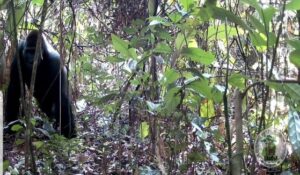EASTERN CAMEROON BIODIVERSITY INITIATIVE: Designing the Great apes migratory corridor
In 2020, the Environment and Rural Development Foundation-ERuDeF launched the Deng-Deng Belabo Gorilla Conservation Corridor Project in Eastern Cameroon to ensure the free movement of key stone species identified in the landscape such as Western lowland gorillas, central chimpanzees and African Forest Elephants and at the same time assisting communities in these areas to create their community forests. One of the most significant components of this initiative is the creation of Great Apes migratory corridor. The Great Apes migratory corridor initiative sought to create a continuous forested corridor that will allow the great apes to migrate freely between different forested areas.
The Eastern Region of Cameroon is one of the last remaining strongholds of the great apes, including the Western Lowland Gorilla and the Central Chimpanzee. These great apes are facing a growing threat due to habitat fragmentation, hunting, and other human activities. This project is addressing these threats by creating a safe and continuous forested corridor that will allow the great apes to migrate freely between different forested areas. This corridor is about 400 km long and will connect the Deng-Deng National Park in the Lom and Djerem Division to the Dja Biosphere Reserve in the Haut-Nyong Division, all in Eastern Cameroon and will also benefit other wildlife species that depend on the forested habitats, such as African forest elephants, white bellied pangolins, and various species.
To achieve these goals, the Great Apes migratory corridor project involved several key activities. The first step was to identify the most suitable areas for the corridor and to conduct a thorough ecological assessment of these areas. This assessment involved mapping the vegetation types, identifying key wildlife species, and assessing the threats and opportunities for the corridor. Based on this assessment, the project team then designed and implemented a range of conservation activities, such as forest restoration, anti-poaching patrols, and community engagement programs.
One of the critical success factors of the Great Apes migratory corridor project is community engagement. By involving them in the project, the team has created a sense of ownership and pride in the conservation efforts, which is enhancing the long-term sustainability of the project.
Also, the Great Apes migratory corridor project is a collaborative effort involving several organizations, including the Cameroon Ministry of Forestry and Wildlife, ERuDeF as the lead organisation and the World Land Trust as the funder of the project since 2020. This collaboration has ensured that the project is well-coordinated and has access to a range of expertise and resources. It also helps to leverage the support of different stakeholders, including governments, NGOs, and the private sector, to achieve the project’s goals.
Another interesting prospect in this project is the development of a carbon finance mechanism which will involve a combination of council forests that are expected to secure at least 50,000ha of land. It should be noted that the project named the Deng-Deng Belabo Conservation Corridor Project cuts across four councils in the East region namely; the Belabo council, the Doume council, the Abong-mbang council and the Mindourou council.
Overall, the Great Apes migratory corridor project is a critical initiative that has the potential to make a significant impact on the biodiversity of the Eastern Region of Cameroon and provide a model for future conservation initiatives in the region and beyond.




Commentaires récents